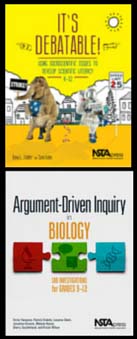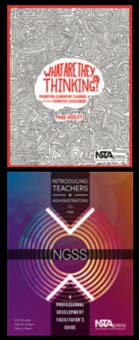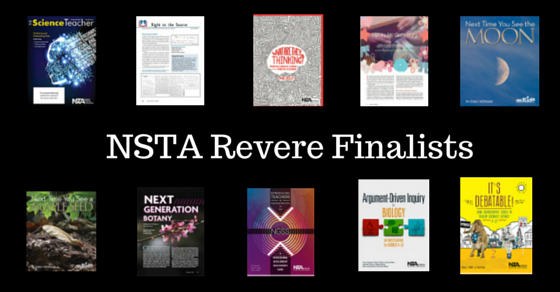Explore Outstanding Educational Resources: 2015 REVERE Awards Finalists
By Claire Reinburg
Posted on 2015-05-14
Each year, the Association of American Publishers (AAP) PreK–12 Learning Group reviews hundreds of educational resources to select the best of the best for the REVERE Awards. AAP has just announced the 2015 REVERE Awards Finalists, and NSTA is pleased to have 10 publications on the Finalists list. Congratulations to the authors of these publications and to NSTA staff members for reaching the final round of 2015’s most prestigious awards in educational publishing! Read on to learn more about these and all the Finalists among this year’s educational resources.
 Explore the Finalists in Resources for “Beyond the Classroom”
Explore the Finalists in Resources for “Beyond the Classroom”
Author Emily Morgan’s Next Time You See series is designed to inspire elementary-age children to experience the enchantment of everyday objects and phenomena and encourage them to learn more about the natural world. Next Time You See the Moon showcases photos of the different phases of the Moon and key information about why the Moon looks different at various points in time. Download an excerpt of Next Time You See the Moon for a look inside this unique children’s book. Next Time You See a Maple Seed (timely for spring!) is chock full of facts and detailed photos of the mysterious-looking winged seeds that maple trees shed. Young children will learn all about how these fruits of maple trees, called samaras, help disperse seeds and what’s required for seeds to grow into the tall maples we see around us. You can download an excerpt from Next Time You See a Maple Seed for a glimpse at the book’s story of a seed’s journey and growth. Visit AAP’s website to see all the REVERE Awards Finalists in the Beyond the Classroom category.
 Explore the Finalists in Supplemental Resources
Explore the Finalists in Supplemental Resources
What better way to help students see how central science is to understanding and participating in our complex world than to introduce lessons that require them to delve into everyday issues? Dana Zeidler and Sami Kahn’s book It’s Debatable! Using Socioscientific Issues to Develop Scientific Literacy, K–12 can help you bring science to life for students through lessons on topics such as “Should schools charge a ‘tax’ to discourage kids from eating unhealthy foods?” and “Should rare Earth elements be mined in the United States?” Download the free unit “A Need for Speed: Should Speed Limits Be Lowered to Reduce Traffic Fatalities?” for a sample from this collection of lessons.
The goals of science education today include helping students not only understand important concepts but also learn to do science. One increasingly popular way to knit all these elements together is argument-driven inquiry, an innovative approach to lab instruction and the focus of Argument-Driven Inquiry in Biology: Lab Investigations for Grades 9–12, by Victor Sampson and coauthors. The emphasis in these labs is on argumentation—the process of proposing, supporting, evaluating, and refining claims in the science classroom. Download the sample chapter “Explanations for Animal Behavior: Why Do Great White Sharks Travel Over Long Distances?” for a lab that will introduce students to many of the theories and concepts used by biologists to study and explain the behavior of animals. Visit AAP’s website to see all the Finalists in the REVERE Awards Supplemental Resources category.
 Explore the Finalists in Professional Resources
Explore the Finalists in Professional Resources
Teachers don’t have to become mind readers to understand the ideas young students bring to science class. The formative assessment probes in What Are They Thinking? Promoting Elementary Learning Through Formative Assessment, by Page Keeley, guide teachers in how to draw out what students know (or think they know) about the natural world so they can tailor lessons to help students gain deeper understanding of science concepts. Covered topics range from why you can’t always see the Moon in the daytime to where water goes when it evaporates. Teacher notes and advice on how to encourage evidence-based discussions in the classroom are included in addition to a set of study group questions. Download the sample formative assessment probe “Pushes and Pulls” for a helpful tool to explore your students’ ideas about forces.
Eric Brunsell, Deb Kneser, and Kevin Niemi created their guidebook Introducing Teachers and Administrators to the NGSS: A Professional Development Facilitator’s Guide to help the science education community begin implementing the exciting changes called for in the Next Generation Science Standards. Their book provides tips, suggestions, resources, and a series of activities that can inform professional development experiences around the NGSS. Download the chapter “Introducing the NGSS“ for an activities-filled primer on the new standards and the conceptual shifts contained in them. Visit AAP’s website to see all the REVERE Awards Finalists in Professional Resources category.
 Explore the Finalists in Magazines
Explore the Finalists in Magazines
In “Next Generation Botany” (The Science Teacher, October 2014), authors Stephen Rybczynski, Zheng Li, and R. James Hickey discuss how important it is to integrate plant biology into the science classroom, given the botanical challenges society faces associated with food production, climate change, invasive species, and biodiversity.
“Right to the Source: Exploring Science and History With the Library of Congress” is a column introduced in The Science Teacher in 2014. Each column features a science-related primary source from the collections of the Library of Congress—a photograph, letter, film, or other artifact—intended to spark conversations and inspire research investigations. The text explains the object’s place in the history of science and offers ideas and links for further research. Recent columns include “Right to the Source: Marconi Sends His Regrets” (The Science Teacher, September 2014) and “Right to the Source: The Secrets of Patent Medicines” (The Science Teacher, October 2014).
In “STEM in a Hair Accessory” (Science and Children, November 2014), authors Hui-Hui Wang, Barbara Billington, and Ying-Chih Chen offer a creative way to introduce STEM (Science-Technology-Engineering-Mathematics) education to students in an informal setting. The article combines three aspects of current science teaching that show up often in Science and Children: incorporating STEM, reaching ALL students (in this case, African American girls), and capitalizing on students’ interests.
The November 2014 issue of The Science Teacher on the theme “Analyzing and Interpreting Data” offers articles filled with ideas for including this important scientific practice in your own teaching. Our world is awash in a sea of data. We encounter more data on a daily basis than ever before, conveying information about weather, health, politics, finance, and science. Data arrives via sensors, social media, digital photos, weather stations, and many other sources. As our ability to store and share data increases exponentially, our students must develop the skills and habits of mind necessary to analyze and interpret information. The Next Generation Science Standards recognize Analyzing and Interpreting Data as one of the eight essential practices of science and engineering. Visit AAP’s website to browse all the REVERE Awards Finalists in the Magazines categories.
The mission of NSTA is to promote excellence and innovation in science teaching and learning for all.
Follow NSTA
Disclaimer: The views expressed in this blog post are those of the author(s) and do not necessarily reflect the official position of the National Science Teaching Association (NSTA).



